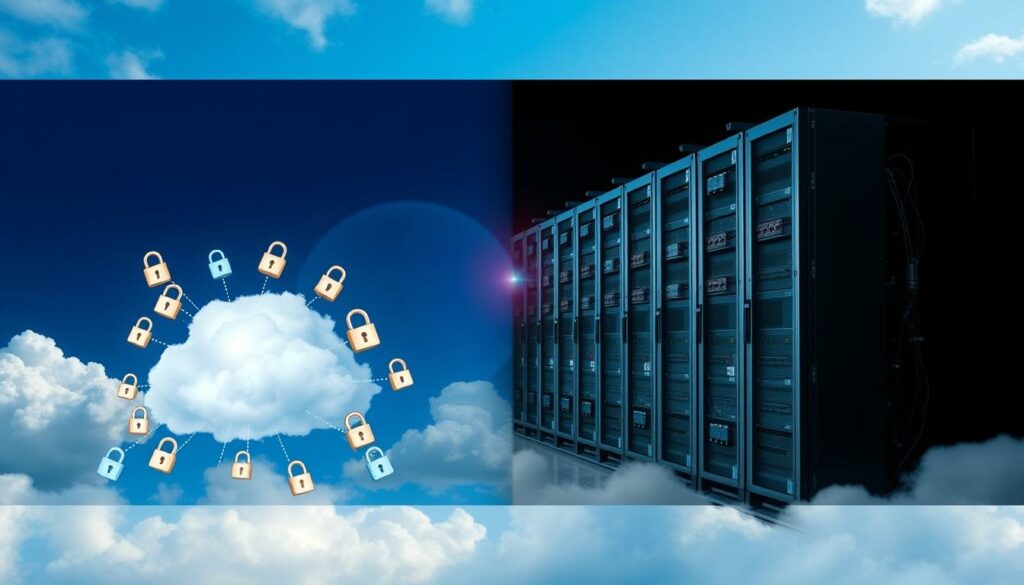Cloud vs Server: Key Differences You Should Know
Choosing between cloud and on-premises servers is a crucial decision for businesses. Cloud computing offers scalability, cost savings, and remote access, transforming IT management.
On-premises servers provide full control over hardware and software, making them ideal for security-sensitive and highly customized applications. While cloud services reduce upfront costs and maintenance, traditional servers offer stability and direct oversight.
The right choice depends on your needs for performance, flexibility, and security.
In this guide, we’ll compare costs, reliability, and scalability to help you determine the best infrastructure for your business. Let’s dive into the cloud vs. server debate.
Understanding the Basics of Cloud Computing
Both cloud computing and traditional servers play vital roles in business IT infrastructure. Cloud computing provides scalable, remote-access solutions, while traditional servers offer direct control and customization.
Understanding their strengths and weaknesses is key to choosing the right option. The advantages and disadvantages of cloud computing vary depending on business needs.
While the cloud reduces costs and maintenance, it may raise concerns over data control and security. Traditional servers, though reliable and customizable, require significant investment and upkeep.
This guide explores the differences to help you determine which infrastructure best suits your organization.

What Is a Traditional Server?
A traditional server is a physical machine dedicated to handling an organization’s computing needs. Unlike cloud-based solutions, which rely on remote infrastructure, data centers or colocation facilities typically house traditional servers on-premises.
These servers offer full control over hardware, software, and security configurations. They are ideal for businesses with strict compliance requirements or highly sensitive data.
Traditional servers come in various types, each serving a distinct purpose:
- File servers: Store, manage, and share files across a network.
- Application servers: Host and execute software applications.
- Database servers: Store, organize, and retrieve structured data efficiently.
- Web servers: Serve websites and manage internet traffic requests.
Traditional servers provide high performance, customization, and reliability. However, they require substantial upfront investment, regular maintenance, and a dedicated IT team for updates, security, and hardware failures.
Businesses must weigh these factors against their operational needs and budget constraints when choosing between traditional servers and cloud computing solutions.
What Is Cloud Computing?
Cloud computing delivers computing resources over the internet, eliminating the need for businesses to maintain physical hardware on-site. This model enables organizations to scale their IT infrastructure on demand, reducing upfront costs and improving operational efficiency.
With cloud services, businesses can access data and applications from anywhere with an internet connection, promoting flexibility and collaboration.
The National Institute of Standards and Technology (NIST) defines cloud computing as an on-demand model for shared resources. This model allows for rapid deployment and scalability.
The transition to cloud-based infrastructure has been significant. By 2021, Cisco reported that 94% of workloads had moved to cloud data centers.
Here are the three primary models of cloud computing:
- Infrastructure as a Service (IaaS): Businesses rent essential IT infrastructure, such as servers, storage, and networking resources.
- Platform as a Service (PaaS): Provides a development environment where businesses can build, test, and deploy applications.
- Software as a Service (SaaS): Delivers applications via the cloud, eliminating the need for local installation.
Cloud vs Server: Key Comparisons
Choosing between cloud computing and traditional servers requires a thorough understanding of key factors like cost, scalability, security, and performance. Cloud solutions offer flexibility, lower upfront costs, and remote accessibility, making them ideal for businesses that prioritize agility.
On the other hand, traditional servers provide full control over infrastructure. This makes them suitable for industries with strict compliance and security needs.
In this section, we’ll break down the main differences between cloud and server infrastructure. This will help you determine which option best aligns with your business requirements. From accessibility to deployment speed, here’s how they compare.
1. Accessibility & Scalability
Choosing between cloud and traditional servers often depends on how easily users can access data. It also depends on how efficiently systems can scale with demand. Businesses today require flexible solutions that support remote work and dynamic growth.
Here’s how cloud and on-premise servers compare in terms of accessibility and scalability.
- Cloud: Cloud-based systems enable access from any device with an internet connection, supporting remote work and global collaboration. They offer flexible, pay-as-you-go scalability, allowing businesses to expand storage, processing power, or user capacity instantly without upfront hardware costs.
- Traditional Server: On-premise servers require physical access or network connections, limiting remote capabilities. Scaling involves purchasing and installing additional hardware, making growth slower and more expensive. Expansions can also cause downtime and operational disruptions, reducing efficiency compared to cloud solutions. Businesses with distributed teams may find traditional servers less adaptable to modern work environments.

2. Cost Considerations
When evaluating cloud and traditional servers, cost is a crucial factor. Businesses must consider both initial investments and long-term expenses when choosing the best infrastructure for their needs.
- Cloud: Cloud computing eliminates the need for upfront hardware investment, making it a cost-effective option for businesses of all sizes. Instead of purchasing and maintaining physical servers, companies pay only for the resources they use. Entry-level cloud servers start at approximately $47 per month (8GB RAM, 100GB storage), while mid-range options cost around $92 per month. The pay-as-you-go pricing model allows businesses to scale their usage based on demand, reducing wasted resources and optimizing expenses. Additionally, cloud providers handle maintenance, updates, and security, minimizing internal IT costs.
- Traditional Server: On-premise servers require a substantial initial investment, including purchasing hardware, setting up infrastructure, and hiring IT staff for maintenance. Beyond the upfront costs, businesses must budget for ongoing expenses such as power consumption, cooling, hardware upgrades, and security measures. Over time, these costs can exceed cloud-based solutions, making traditional servers less cost-efficient, especially for businesses with fluctuating workloads.
3. Performance & Reliability
Performance and reliability are critical factors when choosing between cloud and traditional server solutions. Businesses need a system that ensures consistent uptime, fast processing speeds, and minimal risk of data loss.
- Cloud: Cloud servers leverage redundant infrastructure spread across multiple data centers, significantly reducing the risk of downtime. Providers offer automated backups, sometimes as frequently as every 15 minutes. This ensures that the system protects data and allows for easy restoration in case of failure. Cloud solutions also use load balancing and resource optimization to maintain performance, even under heavy workloads. However, cloud performance can depend on internet speed and network reliability, which may impact responsiveness in certain situations.
- Traditional Server: On-premise servers deliver stable, predictable performance, making them ideal for resource-intensive applications such as high-performance computing, large-scale databases, and enterprise software. Since they don’t rely on external internet connections, they offer uninterrupted access to critical data. This is crucial for industries needing full control over computing power. However, without proper maintenance and redundancy, hardware failures can result in significant downtime and data loss.

4. Security & Compliance
Security is a top priority when choosing between cloud and traditional server solutions. Both options offer robust protection, but their approaches differ in terms of control, management, and compliance.
- Cloud: Cloud providers implement advanced security measures, including encryption, firewalls, and continuous monitoring to protect against cyber threats. They comply with industry regulations such as GDPR, HIPAA, and ISO 27001, ensuring businesses meet legal and security requirements. Features like role-based access control (RBAC), multifactor authentication (MFA), and physical security protections at data centers enhance overall security. Cloud providers also manage software updates and patch vulnerabilities, reducing the burden on internal IT teams. Additionally, cloud storage solutions make it easier to share large files securely across teams without compromising data integrity.
- Traditional Server: On-premise servers provide full control over security configurations, making them ideal for businesses handling sensitive or proprietary data. However, managing security requires a dedicated IT team to handle updates, patch vulnerabilities, and monitor threats. Organizations must implement compliance measures manually, and the associated costs, including hardware, maintenance, and security software, can be high.
5. Deployment Speed and Flexibility
The speed at which you can deploy and adjust your infrastructure significantly impacts business agility. Quick deployment allows companies to respond rapidly to market changes, launch new products, or adapt to unexpected demand fluctuations. Flexibility is crucial in today’s fast-paced environment, as businesses need to pivot quickly to maintain competitive advantages and operational efficiency.
- Cloud: Cloud-based systems deploy instantly, allowing businesses to start operations within minutes. With virtual infrastructure, there’s no need to wait for hardware deliveries, installations, or extensive setup. Businesses can easily scale resources up or down according to demand, offering greater operational flexibility. This enables rapid adaptation to market changes and supports agile development and deployment practices.
- Traditional Server: Traditional servers require hardware procurement, physical installation, configuration, and thorough testing, often taking weeks to deploy fully. Upgrading or scaling these servers involves additional time, planning, and potential downtime, limiting flexibility. Consequently, businesses experience delays and reduced agility when responding to new opportunities.
Which Option Is Best for Your Business?
Deciding between cloud and traditional servers depends on your business needs:
- Choose Cloud if: You need scalability, cost efficiency, and remote access. Ideal for startups, growing businesses, and companies with variable workloads.
- Choose Traditional Servers if: You require full control over security, performance, and data management. Best for industries with strict compliance requirements, such as finance and healthcare.
- Hybrid Solutions: A mix of both can offer flexibility — leveraging cloud services for scalability while maintaining on-premises servers for sensitive data.
Wrapping Up: Make the Smart Choice for Your Business
Choosing between cloud computing and traditional servers is more than just a technical decision — it’s about setting your business up for success. Cloud solutions offer flexibility and cost savings, while traditional servers provide unparalleled control and reliability. The best choice depends on your unique needs, but a hybrid approach often delivers the perfect balance.
No matter which infrastructure you choose, secure and efficient file management is crucial. If you need a reliable platform for sharing and storing media without sacrificing quality, DivShare is here to help.
Sign up for DivShare today and take control of your file hosting with fast uploads, secure sharing, and effortless media management.